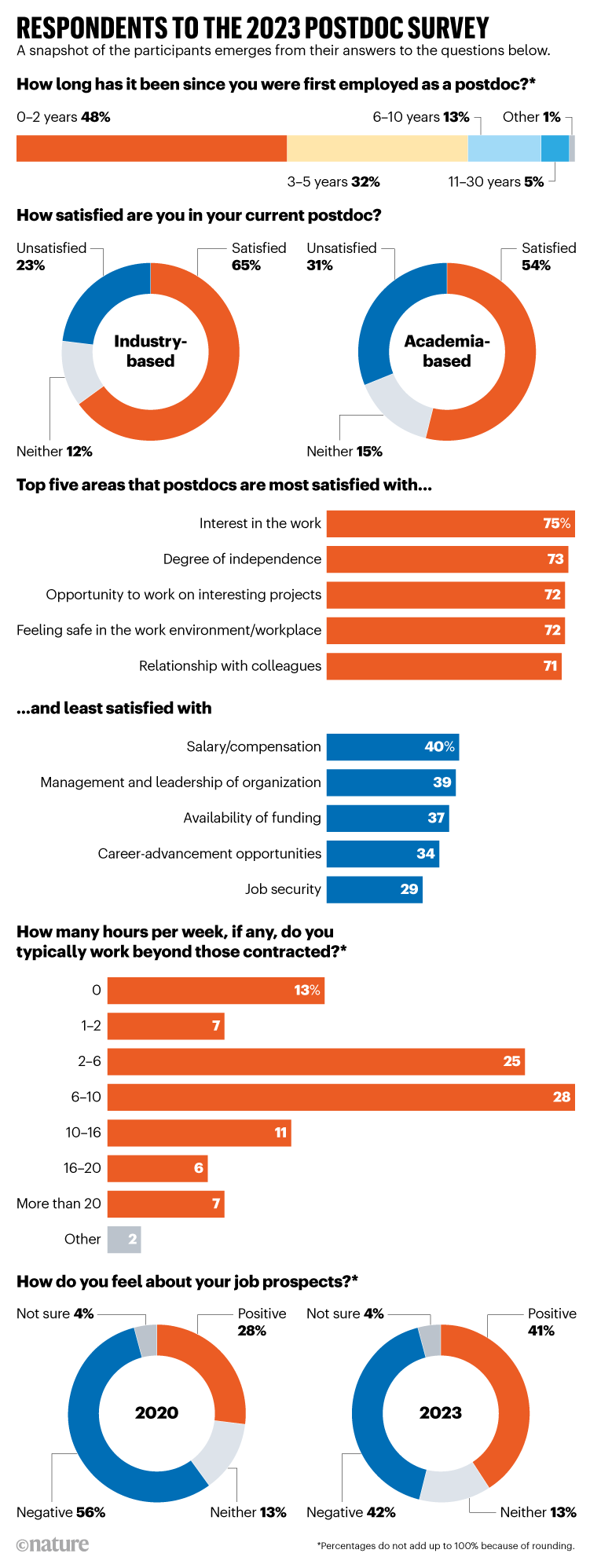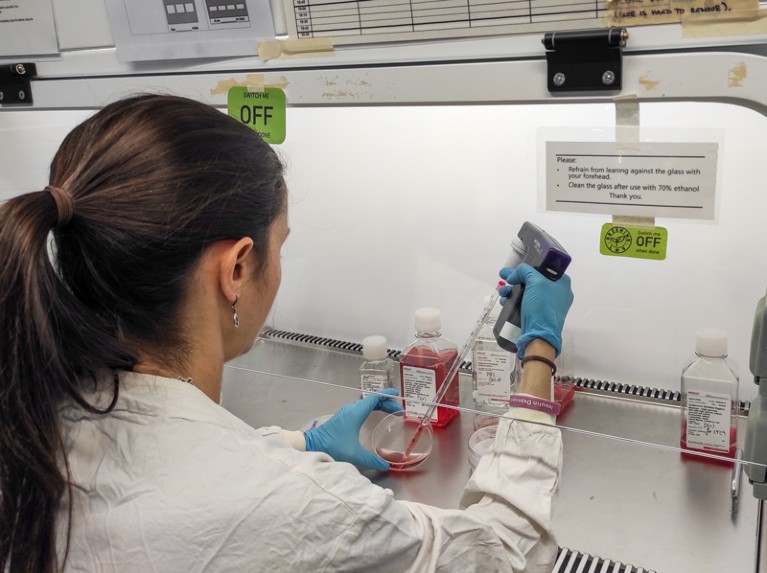
Illustration: Fabrizio Lenci
In 2020, the global coronavirus pandemic put the brakes on Hannah Wardill’s research. As national lockdowns loomed, Wardill — then a postdoc at the University of Adelaide, Australia — left a research project in the Netherlands and flew home before travel bans kicked in. At the time, she feared this would harm her chance to win grants, but in the years since the pandemic, Wardill’s career has flourished. She still doesn’t have a permanent academic position, but leads her own research group in supportive oncology at the University of Adelaide. “The impact of COVID has certainly lifted,” she says.
Wardill is not alone. In 2020, respondents to Nature’s first global survey of postdoctoral researchers feared that COVID-19 would jeopardize their work (Nature 585, 309–312; 2020). Eighty per cent said the pandemic had hindered their ability to carry out experiments or collect data, more than half (59%) found it harder to discuss their research with colleagues than before the crisis, and nearly two-thirds (61%) thought that the pandemic was hampering their career prospects.
That outlook has changed, according to Nature’s second global postdoc survey, carried out in June and July this year. Now only 8% of the respondents (see ‘Nature’s 2023 postdoc survey’) say the economic impacts of COVID‑19 are their biggest concern (down from 40% in 2020). Instead, they are back to worrying about the usual things: competition for funding, not finding jobs in their fields of interest or feeling pressure to sacrifice personal time for work. Overall, 55% say they are satisfied in their current postdoc, a slide from 60% in 2020. This varies by geography, age and subject area. Postdocs aged 30 and younger are more likely to be satisfied (64%) than are those aged 31–40 (53%). Biomedical postdocs — who make up slightly more than half of the respondents — pull the average down, because only 51% say they are satisfied with their jobs.
Reduced concern about COVID-19 is not the only positive trend. The average number of overtime hours has fallen, with 13% saying they don’t do any overtime (up from 9% in 2020). Also, more postdocs are reporting an appropriate level of support for mental health and well-being at their institutions than previously (22%, up from 18% in 2020; see ‘Small gains’), and a good work–life balance (42%, up from 36% in 2020). But the biggest shift is in the proportion of postdocs who feel optimistic about their future careers — swelling from 28% of respondents in 2020 to 41% in 2023 (see ‘Respondents to the 2023 postdoc survey’).

Underappreciated, but optimistic
Overall, however, the data continue to paint postdocs as academia’s drudge labourers: overworked, underpaid, appointed on precarious short-term contracts and lacking recognition for their efforts. Patterns of discrimination and harassment have not changed since 2020. One-quarter of respondents report having experienced either, or both, in their current or previous postdoc. Respondents highlight bullying as the most common form of harassment — encountered by 52% of those who had experienced discrimination or harassment – with managers, supervisors or principal investigators being the most commonly cited perpetrators.

US postdocs on strike: how will demands for higher wages be met?
“Fundamentally, I do not think the postdoc experience has changed,” says Michael Matrone, associate director of the office of career and professional development at the University of California, San Francisco. “What I think has changed, catalysed by the pandemic, is a greater awareness of and intolerance for the oppressive and exploitative systems that exist in academia.”
Julia Sanchez-Garrido feels more optimistic now than three years ago. Back then, she was one of 9 million Londoners trying to stay 2 metres apart from other people. She was also struggling with loneliness and worrying about not being able to access her bacteriology lab at Imperial College London. “I think 2020 was just a very bad year,” she says. “Everything was halted. It was impossible to get lab equipment. You had no social life.”
Now, with about a year left of her current postdoc at Imperial, her biggest worry is job security, but it is tempered by a growing realization that there are many fulfilling options to consider. Although she would like to stay in academia, she has seen many colleagues move to industry. “I think people are happier because they know that they can move out of academia, and it’s not a failure,” she says.

Like many postdocs in Nature’s survey, microbiologist Julia Sanchez-Garrido feels more optimistic than she did in 2020.Credit: Julia Sanchez-Garrido
This year’s survey includes the perspectives of industry-based postdocs for the first time. Although the proportion of these respondents was too small (7% of the total) to do a head-to-head comparison with those in academia, their answers suggest that postdocs in industry have a more positive outlook: for example, 65% describe themselves as satisfied, compared with 54% in academia. They are also better paid (23% earn between US$80,000 and $110,000 annually, versus 5% in academia), better able to avoid overtime completely (20%, compared with 12) and better able to save the amount of money they want (29% versus 19%). They are also more likely to feel that their workplace promotes physical safety (83% compared with 74%) and dignity (65% versus 54%).
One respondent, an ecologist who left a postdoc at a North American university earlier this year for one at a private environmental organization, says she is much happier in her new post. “The biggest thing is that there is a good chance that my current position will turn into a permanent, meaningful position, with great salary and benefits,” wrote the ecologist, who requested anonymity because she does not want to sour relationships with her former employer. No such promises were made in her academic postdoc, she says. Also, she now enjoys better benefits, including free gym membership, a higher salary and an improved work–life balance.
Location matters
In addition to differences between academia and industry, the survey also reveals regional differences. Postdocs based in Africa were most likely to be dissatisfied with their current position (38%), followed by those in North and Central America (34%). By contrast, 58% of postdocs based in Europe reported that they were satisfied with their current jobs, and Australasia-based postdocs were the most likely to be satisfied (68%).
Large proportions of postdocs in Europe (70%) and Australasia (64%) reported job security as a cause for dissatisfaction, whereas those in Africa and South America were dissatisfied with workplace benefits, such as health insurance. And despite earning some of the highest salaries, postdocs in North and Central America are the most dissatisfied with their pay (86% of postdocs in North and Central America earned $50,000 or more annually, compared with 44% in Europe). Nearly two-thirds (62%) of North and Central American postdocs were dissatisfied (giving their salary a score of 1, 2 or 3, with 1 being ‘extremely dissatisfied’), compared with just 27% of Australasian and 38% of European postdocs.

Breast-cancer researcher Samyuktha Suresh says more than half of her postdoc salary goes towards rent in California.Credit: Luci Valentine
Samyuktha Suresh, a breast cancer researcher at Stanford University in California, moved to the United States one year ago after finishing her PhD in France. “I am paid so much more as a postdoc in comparison to my PhD salary in Paris. But I feel so much poorer in terms of how much I can afford,” she says, adding that more than half of her postdoc salary goes towards rent. “Just paying US postdocs more would probably alleviate a lot of problems,” she adds.
Victoria McGovern, chief strategy officer at the Burroughs Wellcome Fund, a private biomedical research funder in Research Triangle Park, North Carolina, says that early-career researchers based in the area used to be able to buy a house — something that helped to make them feel settled and mature. But Californian companies moving into the area caused prices to skyrocket out of the reach of junior researchers. Between October 2020 and September 2023, according to the property website realtor.com, local house prices rose from around $220,000 on average to more than $400,000.
McGovern says that although the mass lay-offs feared at the start of the pandemic didn’t materialize, a hiring crisis in academia has now taken hold, with labs struggling to fill postdoc posts. “Postdocs are being pulled off into six-figure [industry] jobs that pay better than faculty positions, and it’s happening fast,” McGovern says.
Just knowing that there’s an alternative path in industry could help to boost career optimism in academia, McGovern adds, alongside post-pandemic changes to working life and employees’ shifting expectations. “People are a lot more aware of their own agency. It is the sense that they are not trapped, that there’s something that they can go out to do to make their lives better today,” she concludes.
Suresh’s partner left academia for a research position at a semiconductor company in Vancouver, Canada, and often urges her to seek a role in industry. But she is loath to give up on her dream of a permanent faculty position. “I’m optimistic,” she says. “I’m going to try everything that I can to get an academic position first.”
Keeping the faith
Suresh faces tough odds. In Nature’s 2023 data, 65% of respondents say they want to base their careers in academia, a slight rise from 63% in 2020. That is a “very concerning” figure, says Paige Hilditch-Maguire, director of alumni and corporate partnerships at Queensland University of Technology in Brisbane, Australia, adding that it signals a misalignment between expectations and the reality of the academic job market. “It is extremely unlikely that 65% will end up in tenured or in long-term academic positions in their fields.” Most data suggest it’s more like 20%, and the proportion is even lower in some disciplines, she says.
Most of the postdocs who spoke to Nature hope to stay in academia, despite knowing the difficulties. Some feel their chances might have improved as more of their competitors leave for industry.

Lab leaders wrestle with paucity of postdocs
Reuben Levy-Myers, who started his first postdoc in neuroscience at University of California, San Diego, in May, says he found the application process less stressful than he had been led to believe. “Basically, it feels like the people that have chosen to stay in academia may have an easier time than a few years ago because there are so few of us left. I worry about a downward spiral where there are not enough postdocs, so not enough research gets done.”
Bruce Weaver, a physics postdoc at the Swiss Federal Institute of Technology in Lausanne, also wants to give academia a go. He is happier now than he was in 2020 as a PhD student at Imperial College London. His pay is good, he says, and so is his work–life balance. “You read articles that imply that lots of people don’t want to be postdocs, but once you’re here, there’s lots of good things about the job,” he says.
Others have found a sense of optimism through engaging in activism that aims to change the way postdocs are treated in academia. Postdocs in the United States and elsewhere are banding together to fight low pay and a lack of recognition. In the past year, postdocs at several US universities have embarked on strike action, and there are ongoing discussions about a national postdoc union to boost their bargaining power.
Earlier this year, Tim MacKenzie, a genetics postdoc at Stanford, and others on Stanford’s postdoc council published a report analysing the poor working conditions of US-based postdocs in general, and at Stanford specifically (see go.nature.com/46ukji1). The report found them to be in occupational limbo: neither students, nor staff.
Seeing others rally behind the report’s message has given MacKenzie a sense of optimism. “There’s a lot of work to be done. And none of us can do it alone,” he says. “We are empowered. That’s been something that’s really inspiring for me and gives me a bit of hope moving forward.”

